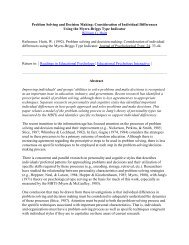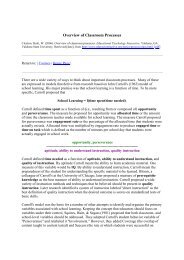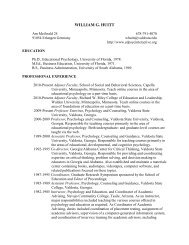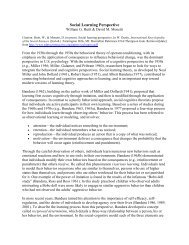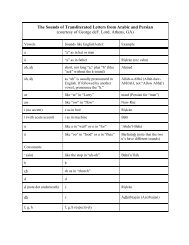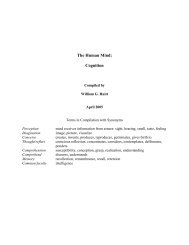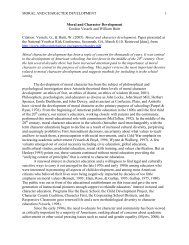Physical Development - Educational Psychology Interactive
Physical Development - Educational Psychology Interactive
Physical Development - Educational Psychology Interactive
You also want an ePaper? Increase the reach of your titles
YUMPU automatically turns print PDFs into web optimized ePapers that Google loves.
PHYSICAL DEVELOPMENT 1<br />
An Overview of <strong>Physical</strong> <strong>Development</strong><br />
Michelle Caldwell and William Huitt<br />
Citation: Caldwell, M., & Huitt, W. (2004). An overview of physical development. <strong>Educational</strong><br />
<strong>Psychology</strong> <strong>Interactive</strong>. Valdosta, GA: Valdosta State University. Retrieved [date] from<br />
http://www.edpsycinteractive.org/papers/physdevelop.pdf<br />
If the youth of today are to be educated from a more holistic perspective, it is imperative that a<br />
concerted effort be made to teach the importance of the physical domain. This paper provides an<br />
overview of the importance of maintaining physical fitness and proper nutrition as well as an<br />
overview of the means by which this physical fitness can be obtained and maintained.<br />
Cardiovascular endurance, muscular strength, muscular endurance, flexibility, and body<br />
composition are components of physical fitness; consuming a healthy diet that includes grains,<br />
fruits and vegetables, and lean protein sources are aspects of good nutrition. The paper also<br />
reviews literature related to the assessment of components of physical fitness.<br />
The education of children and youth today encompasses much more than the traditional<br />
reading, writing, and mathematics seen in years past. According to Huitt (2004), there is a need<br />
to consider the education of our young people from a more holistic perspective. This paper will<br />
address the importance of considering the physical development of children and youth.<br />
Booth, Chakravarthy & Spangenburg (2002) propose that the human body is genetically<br />
prepared for a higher level of physical activity than is current among most people in postindustrial<br />
societies and that physical functioning of the body influences all other domains of the<br />
individual. This relationship is best described through the concept of wellness, referring to the<br />
total health of the individual including the mental, physical, emotional and spiritual domains<br />
(Edlin, Galanty & Brown, 2002). From the perspective of wellness, each aspect of one’s health<br />
must be viewed with equal importance because they are all intertwined. If one area of health is<br />
neglected, other domains suffer as well.<br />
At the same time that there is a concerted effort to raise test scores (Rebora, 2004), there<br />
is a steady decline in the overall physical health of our nation (U.S. Department of Health and<br />
Human Services, 2001). Two diseases in particular are increasing in epidemic proportions:<br />
obesity and Type 2 diabetes. This rise is linked with two major factors: physical inactivity and<br />
poor nutritional habits.<br />
The Surgeon General reported that nearly 50 million adults between the ages of 20 and<br />
74 are obese. Overall, more than 108 million adults are either obese or overweight. That is an<br />
astounding 61% of the U.S. population. Though previously considered an adult disease, Type 2<br />
diabetes has increased dramatically in children and adolescents,. Laino (2003) reported that one<br />
in three American children born in the year 2000 will develop diabetes if they adopt the nation’s<br />
inactive and overeating lifestyle.<br />
One way to address these issues and curb these trends is to better educate our children<br />
and youth about the importance of regular physical activity and proper nutrition. Exposure to<br />
these topics beginning in early childhood is crucial to the healthy development of our youth.<br />
Throughout the remainder of this paper, more specific issues regarding physical development<br />
will be explored, suggestions will be made as to what parents and educators can do to help<br />
promote physical development, and measurement issues will be considered that can help the<br />
educators, parents, and the community take more responsibility for the health of our nation.
PHYSICAL DEVELOPMENT 2<br />
Fitness Component<br />
When discussing the physical domain of the human body, it is important to consider five<br />
health-related fitness components: cardiovascular endurance, muscular strength, muscular<br />
endurance, flexibility, and body composition.<br />
Cardiovascular endurance is defined as the ability of the lungs, heart, and blood vessels to<br />
deliver adequate amounts of oxygen and nutrients to the cells to meet the demands of prolonged<br />
physical activity. The American Heart Association (2004b) reported that cardiovascular disease<br />
is the number one killer in America. Therefore, activities promoting cardiovascular fitness are<br />
extremely important in the prevention of this life threatening disease as well as other<br />
degenerative illnesses that can be related to poor cardiovascular endurance.<br />
The second and third components of health related fitness are muscular strength and<br />
muscular endurance. Muscular strength is the ability of the muscle to exert a single maximum<br />
contraction, where as muscular endurance is the ability of the muscle to work for long periods of<br />
time without getting tired. Muscular strength and endurance are extremely important for<br />
everyday living. Daily activities such as climbing stairs, carrying groceries, as well manual labor,<br />
require both strength and endurance of the muscles.<br />
Although it is often times overlooked, flexibility is yet another key component to health<br />
related fitness. Flexibility is defined as the joints ability to move through a full range of motion.<br />
Excellent flexibility provides various health related benefits, which include improved physical<br />
performance, greater freedom of movement, improved posture, an increase in physical and<br />
mental relaxation, and a decrease in the risk of injury. Although an individual’s level of<br />
flexibility is primarily due to genetics, gender, and age, it is important to recognize that the level<br />
of physical activity plays an important role as well. In simple terms, the less physically active we<br />
are, the less flexible we are likely to be.<br />
Probably the most outwardly visible sign of an individual’s level of physical activity is<br />
body structure or body composition. Body composition is the percentage of fat and muscle that<br />
makes up a person’s body (Rimmer, 1994). For good health, an individual should maintain a<br />
proper ratio of one to the other. When levels of body fat are high, an individual is at greater risk<br />
for a variety of health problems. High percentages of body fat are strongly correlated with<br />
arthritis, heart disease, hypertension, and diabetes. There are many different ways to find body<br />
composition; however, not all are accurate. Height and weight charts are probably one of the<br />
least accurate means of finding body composition. An individual’s muscle mass is not taken into<br />
consideration; therefore, someone may be considered obese when in reality they have a large<br />
amount of lean muscle in the body. Body mass index (BMI), another commonly used measure of<br />
body composition, assesses one’s body weight relative to height. A person with a BMI under<br />
18.5 is considered underweight. BMI values of 18.5-25.9 is considered normal, 25-29.5 is<br />
considered overweight, and 30 or over is considered obese. The National Center for Chronic<br />
Disease Prevention and Health Promotion (2004) provides a easy-to-use, web-based process for<br />
calculating BMI.<br />
Understanding the importance of body composition is essential when considering issues<br />
regarding overall health. In most schools, when fitness testing is administered, the body<br />
composition component of the test is removed because it is considered embarrassing to the child<br />
if the percentage of body fat is too high. However, as educators, it is necessary to provide this<br />
information to the student and parents, taking the same care with physical data as with academic
PHYSICAL DEVELOPMENT 3<br />
achievement data. Dealing with the issue while the student is still in schoolcould actually save<br />
the individual’s life later.<br />
Influencing Factors<br />
There are two major factors that influence each of the health related fitness components:<br />
physical activity and nutrition. Education in both areas is critical in helping an individual to<br />
develop overall physical health.<br />
The benefits of physical activity have been viewed as important in our society for many<br />
years. However, it was not until the second half of this past century that evidence from a<br />
scientific standpoint began to support these beliefs (Cooper, 1991,1999). There is an<br />
accumulating body of evidence to support the fact that young children are becoming less<br />
physically active and more overweight and obese. For example, the Centers for Disease Control<br />
(CDC; 2000) reported that physical inactivity has contributed to the 100% increase in the<br />
prevalence of childhood obesity in the United States since 1980. In addition to issues regarding<br />
obesity, many studies on physical activity have shown that the body responds to exercise in ways<br />
that have positive effects on the cardiovascular, respiratory, endocrine, and musculoskeletal<br />
systems. More specifically, physical benefits of exercise such as increased muscle strength,<br />
range of motion, flexibility, posture, and endurance, all promote self-sufficiency and decrease<br />
feelings of depression, dependence, and lack of control. Regular participation in physical activity<br />
also appears to reduce anxiety, improve mood, and enhance an individual’s ability to perform<br />
daily tasks. Also, emerging research in animals and humans alike suggests that physical exercise<br />
may boost brain function, improve mood, and otherwise increase the capacity for learning<br />
(Kong, 1999).<br />
Proper nutrition is the other major factor that influences physical development. Many<br />
adults have been taught incorrect information about nutrition and are teaching this to their<br />
children (Willett, Skerrett, & Giovannucci, 2001). For the well being of our children, adults need<br />
to become more aware of what proper nutrition encompasses and attempt to instill proper<br />
nutritional habits in children from an early age. Unfortunately, some of the information coming<br />
from respected sources is inaccurate (Willett, 2001). For example, the Dietary Guidelines for<br />
Americans published by the United States Department of Agriculture (1995) suggests that the<br />
daily diet should contain 6 to 11 servings of foods high in carbohydrates such as bread, cereal,<br />
rice, and pasta. However, the suggestions from faculty at the Harvard School of Public Health<br />
(Willett, et al.) propose these foods should be used sparingly. While both suggest eating healthy<br />
foods such as grain products, fruits and vegetables, low-fat dairy products, beans, lean meat,<br />
poultry, fish, or nuts, the recommended portions of each are often quite different (see Willett,<br />
2001 for a detailed comparison).<br />
It is also important that adults teach children healthy eating by example. Children should<br />
not only hear educators and other adults telling them how they should eat, but they should also<br />
see those around them eating these same healthy foods. There is a caveat in the recommendations<br />
from experts: dietary guidelines are intended for children over the age of two years. Infants from<br />
birth to the age of two need a higher amount of fat intake in their diet because of their rapid<br />
growth rate. The American Heart Association (2004) states that beginning around the age of two,<br />
toddlers can be moved on to the recommended dietary guidelines recommended for adults.<br />
Parents should consult their family pediatrician for more specific dietary guidelines for an infant.
PHYSICAL DEVELOPMENT 4<br />
Staying up-to-date on current information regarding nutrition and following recommended<br />
dietary guidelines are important factors in being able to help properly educate our youth.<br />
<strong>Educational</strong> Programs<br />
There needs to be a concerted national effort to curb the current trends of cardiovascular<br />
disease, obesity, Type 2 diabetes, and other degenerative illnesses related to physical inactivity<br />
and improper nutrition. In order to take a step in the right direction, the first priority must<br />
become stressing a greater importance in the area of physical development in our educational<br />
system. One of the most distressing statistics of all in the relationship of disease and physical<br />
inactivity are the statistics that show physical education programs throughout our nation are<br />
being placed on the back burner. The CDC (2000) reported that nearly half of young people 12-<br />
21 years of age are not vigorously active. For most children, physical education class is the only<br />
place they will have any type of exposure to physical activity. Yet, only one state, Illinois,<br />
requires daily physical education in all grades K-12. In Georgia, only one semester of health and<br />
physical education combined in high school is required for graduation. If this is the case, what<br />
can educators and parents do to help children and youth in the area of physical development<br />
<strong>Physical</strong> Education Programs<br />
From an educational standpoint, it is imperative that standards be established that will<br />
guide the physical development of children and youth throughout their years of formal schooling.<br />
Effective physical education programs should set clear expectations of students, specifically<br />
designed as age appropriate. Expectations should not only cover the development of motor skills,<br />
they should include aspects of the cognitive and affective domains as well. Those in charge of<br />
setting standards, such as those implemented in South Carolina (South Carolina Department of<br />
Education, 2004), should be applauded for showing a commitment to the overall health of their<br />
children.<br />
In South Carolina, seven different standards must be met if an individual is to be<br />
considered physically educated. All standards are addressed at each grade level, though each is<br />
modified so that it is age appropriate. In addition, all standards at each grade level are given an<br />
example of assessment that are used to monitor student learning and development. For example,<br />
physical education standard number one states that students should be able to demonstrate<br />
competency in many movement forms and proficiency in a few movement forms. The standard<br />
is then modified for age appropriateness so that, in preschool and kindergarten, the standard<br />
specifies that students should be able to display most fundamental movement patterns (e.g.,<br />
throwing, receiving, jumping, and striking) in simple conditions and demonstrate control of the<br />
varied use of these patterns.<br />
Each standard includes several benchmarks so that student learning can be monitored. An<br />
example of a benchmark for preschool and kindergarten is: the student will travel with control<br />
forward, backward, and sideways using a variety of locomotor patterns and change directions<br />
quickly. In addition to the benchmarks, an example of assessment is given which includes<br />
teacher observation along with criteria for assessment of the movement patterns. If the task is to<br />
demonstrate a locomotor skill (e.g., slide, hop, skip, or gallop), the teacher assesses the task and<br />
three points are given if the student demonstrates each pattern at a level of mature form. If the<br />
student demonstrates the beginnings of each pattern but it is not fully developed, two points are
PHYSICAL DEVELOPMENT 5<br />
given. Finally, one point is given if there is no evidence that the student can demonstrate the<br />
pattern at the time. This is just one example of the format used for students in the state at each<br />
grade level. The South Carolina Department of Education (2004) website provides further<br />
information regarding effective physical education programs and a complete list of state<br />
standards. It is of utmost importance that all educational systems adopt these kinds of standards<br />
and make a more concerted effort to hold educators accountable for teaching and measuring<br />
them. These issues will be addressed later in the paper.<br />
Age-appropriate Activities<br />
As educators and parents consider how to help children develop the five health-related<br />
fitness components it is important to consider the age-appropriateness of activities. Obviously,<br />
one would not expect a young child in the first or second grade to participate in the same type of<br />
muscular strength and endurance training as a senior in high school. It is necessary to develop<br />
exercise prescriptions for both the elementary, middle grades, and secondary levels. The goal of<br />
the prescriptions is to increase the activity level of all students to at least 60 minutes per day by<br />
suggesting activities which students can engage in outside of the classroom. Within this<br />
prescription, detailed instructions must be given for activities that are age appropriate for the<br />
development of each health-related fitness component; students can chart the time spent engaged<br />
in the various activities for their math classes and write about their exercise in their language arts<br />
classes. It is important to consider that fitness activities need to be made fun for children or they<br />
will not want to participate. For most individuals, giving a direct command to go out and run two<br />
laps will not be an interesting activity in which to participate.<br />
In the area of cardiovascular endurance some fun activities for elementary age and<br />
middle school students might include: flag tag, a 15-minute fun circuit, or a family fun walk. In a<br />
game of flag tag, each student puts a flag in their back pocket. On the signal the students begin<br />
chasing others around the designated area, attempting to grab as many flags as they can. At the<br />
end of 1 minute, stop the game; the person with the most scarves is declared the winner for that<br />
round. The 15-minute fun circuit includes stations for jump rope, jumping over a hoop, jumping<br />
jacks, and mountain climbers. Adding music to the fun circuit makes the activity even more<br />
appealing. The family fun walk is an activity that can take place at home. With the family,<br />
students are encouraged to take a brisk 20- minute walk throughout the neighborhood. A list of<br />
items to be found along the walk can be compiled to make the walk into a scavenger hunt type of<br />
activity.<br />
For middle grade or secondary age students, flag tag can be modified into rollerblade flag<br />
tag. The same directions would apply with the exception that the students are rollerblading<br />
instead of jogging. Jumping rope is another cardiovascular activity that older students can enjoy.<br />
Creating task cards and routines as well as setting the activity to music is an excellent way to<br />
engage students in a cardiovascular workout. It is also important to consider that basic activities<br />
such as jogging, walking, swimming, and aerobic dance are also considered excellent activities<br />
for people of all ages that promote cardiovascular endurance.<br />
When most people think of muscular strength and endurance training, they immediately<br />
think of weight training in the weight room. However, educators should be aware that weight<br />
training is not a feasible activity for younger children. There are many activities that students of<br />
all ages can engage in without ever entering a weight room facility. For elementary age children,<br />
activities like tug-of-war, push-up routines, and the use of a stability ball can all assist in the
PHYSICAL DEVELOPMENT 6<br />
development of muscular strength and endurance. Middle school and secondary level students<br />
can also use the stability balls, yet they may also safely begin workouts within the weight room<br />
environment. It is crucial for educators and parents to understand that teaching proper technique<br />
as well having proper supervision are key elements in a successful weight lifting program.<br />
Body composition can be developed through a variety of activities. The stability ball can<br />
be used to perform sit-ups and crunches for students of all age levels. Each activity can be<br />
modified to fit the ability level of all students. For example, level one would consist of sitting on<br />
top of the ball, lying back and performing a certain number of sit-ups. In level two, there is a<br />
slight increase in the difficulty of the task. At this level, the student slides down the ball with<br />
their back at a slight angle. The student then attempts to perform the set number of sit-ups. Level<br />
three would be the most difficult. The student would lie down with their back on the ground, and<br />
their legs on top of the ball while performing the sit-ups. Older students can also use weight<br />
training as a method of developing body composition. Educators and parents need to also<br />
consider the importance of proper diet along with these methods of exercise when attempting to<br />
develop body composition.<br />
The development of flexibility is mainly acquired through stretching programs. Stretches<br />
can be categorized on a continuum from static (no motion) to ballistic (rapid motion) (Kurz,<br />
1994). Static stretching involves stretching a muscle to the farthest point and holding the stretch.<br />
Isometric stretching is a type of static stretching which involves resistance of muscle groups<br />
through the tensing of the muscles. This type of stretching is considered one of the best ways to<br />
increase flexibility. Passive stretching is sometimes referred to as relaxed stretching. During a<br />
passive stretch, an individual would assume a position and hold it using another part of the body,<br />
a partner, or an apparatus of some type. This type of stretching is good for cooling down after a<br />
workout because it helps to reduce muscle fatigue and soreness. Active stretching includes<br />
assuming a position and holding it there with no assistance other than using the strength of your<br />
agonist muscles. Active stretches are usually very difficult to hold for more than ten seconds and<br />
should not be held anymore than fifteen seconds. One would find this type of stretching in an<br />
activity such as yoga. Dynamic stretching involves moving parts of one’s body and gradually<br />
increasing reach, speed of movement, or both. Dynamic stretching can be useful as part of a<br />
warm-up for an aerobic workout. Ballistic stretching uses the momentum of a moving body part<br />
or limb in an attempt to force it beyond its normal range of motion. This type of stretching is not<br />
considered useful and it has also been known to lead to injury.<br />
As mentioned earlier, any physical activity designed for young children needs to be made<br />
fun. Although stretching routines can be very monotonous, they can be made more exciting for<br />
young children by simply adding music and giving each stretch a unique name.<br />
Classroom-based Activities<br />
Although the physical education classroom is a critical area for the development of the<br />
physical domain, the push for more physically active students should not end there. Educators<br />
need to be aware that young children learn about the world through movement and physical<br />
activity. Classroom teachers should keep in mind that physical activity can be integrated within<br />
other subject areas to give children opportunities for more movement throughout the day.<br />
One way to incorporate this physical activity would be to use a thematic approach to<br />
teaching units within the curriculum. An example of a thematic approach would be an Olympic<br />
Games theme. In the area of Language Arts, students can read books, write reports, and perform
PHYSICAL DEVELOPMENT 7<br />
skits that pertain to the games and athletes of the Olympics. Students can be shown maps in<br />
Social Studies, where they can compare the geographical locations of where they live and the<br />
place where the games are being held. A scale could be made up that shows the number of steps<br />
taken that are equal to a certain number of miles. Students could be given pedometers to<br />
calculate how many steps they have taken since the last class period. Each day when the students<br />
enter the classroom, they would go to the map and chart their “distance traveled” toward the<br />
sight of the Olympic Games. In math class, students can be introduced to the use of stopwatches.<br />
Teachers can have the students’ time each other in a few physical skills and the data collected<br />
can be analyzed and graphs can be made using the results. Finally, in physical education classes,<br />
students could participate in activities similar to those of the Olympic Games. Through the use of<br />
this theme, each subject area teacher will have then done a small part in incorporating some type<br />
of physical activity into their classroom.<br />
Parent Involvement<br />
In addition to introducing children to physical activity through physical education<br />
programs and integrated curriculum parents can be encouraged to become involved in this aspect<br />
of their children’s development. Children today are leading a more sedentary lifestyle than ever<br />
before (U.S. Department of Health and Human Services, 2001). The days of coming home from<br />
school and playing outside until dark have been replaced with activities such as watching<br />
television, surfing the internet, and playing video games. However, there are many things that<br />
parents can do to get children out of the house and involved in some type of physical activity<br />
(New York Online Access to Health, 2004). Some of these activities may include taking family<br />
walks or bike rides, going to the park or other recreational facilities, encouraging participation in<br />
extracurricular activities, and encouraging playtime outdoors. Parents should also get involved in<br />
school activities. They can ask their children what they are doing in physical education or better<br />
yet, visit them in class. Encouraging them to practice skills learned or practicing with them can<br />
be an effective way to keep them turned on to physical activity.<br />
Measurement and Evaluation<br />
The final issue that must be addressed is how appropriate development of children and<br />
youth in the physical domain can be addressed. It is our belief that the answer is simple. Fitness<br />
testing within the educational system must be required and educators must be held accountable if<br />
standards are not met. Testing is required in all other areas of education and physical<br />
development should not be held to any lower standards.<br />
There are three different programs that provide excellent examples of effective tools for<br />
measurement within physical education: FITNESSGRAM, <strong>Physical</strong> Best, and the President’s<br />
Challenge <strong>Physical</strong> Activity and Fitness Awards Program. FITNESSGRAM is a health related<br />
physical fitness assessment that was developed in 1982 (The Cooper Institute, 2001). The goal of<br />
this program is to develop an easy way for physical educators to report the results of physical<br />
fitness assessments to parents. Each student is assessed in three areas of health-related fitness:<br />
aerobic capacity, body composition, and muscular strength, endurance, and flexibility. Activities<br />
within the category of aerobic capacity include The Pacer (a 20 meter progressive, multi-stage<br />
shuttle run set to music), a one mile walk/run, or a walk test which is commonly used for<br />
secondary students. In the area of body composition, percent body fat can be calculated by taking
PHYSICAL DEVELOPMENT 8<br />
skin fold measures from the triceps and calf or through Body Mass Index which is calculated<br />
from height and weight. Muscular strength, endurance, and flexibility can be measured in one of<br />
several ways. Abdominal strength is evaluated through a curl-up test. Trunk extensor strength<br />
and flexibility is evaluated by means of the trunk lift. Upper body strength can be measured by<br />
either the 90 degree push-up, the pull-up, flexed arm hang, or modified pull-up. Finally,<br />
flexibility can be measured by the sit-and-reach test. When testing is complete, students are<br />
compared on an individual basis to health related fitness standards that were carefully established<br />
for age appropriateness and gender. Each student tested receives a report which contains<br />
objective, personalized feedback and positive reinforcement. This is critical in changing behavior<br />
patterns and it also serves the purpose of essential communication between educators and<br />
parents. In order to obtain the maximum benefit of the fitness test, a pre-test and post-test should<br />
both be administered. This is the only way to tell if progress has been achieved throughout the<br />
student’s time in physical education.<br />
<strong>Physical</strong> Best is considered to be a companion product of FITNESSGRAM (American<br />
Fitness Alliance, 2001). It is considered to be a complete educational program for teaching all<br />
areas of health related fitness. It was developed by the American Alliance for Health, <strong>Physical</strong><br />
Education, Recreation, and Dance (AAHPERD) and it includes learning activities for aerobic<br />
capacity, muscular strength, endurance, and flexibility, and body composition. The <strong>Physical</strong> Best<br />
program contains materials, books, computer software, as well as hands on training through<br />
workshops that attempt to assist physical educators in impacting the long-term health of their<br />
students.<br />
The final program to be considered is The President’s Challenge <strong>Physical</strong> Activity and<br />
Fitness Awards program (see http://www.presidentschallenge.org/). What began as a simple<br />
physical fitness test has expanded its Presidential Active Lifestyles Award (PALA; see<br />
http://www.presidentschallenge.org/earn_awards/awards_available.aspx). PALA recognizes<br />
children between the ages of six and eighteen for being physically active at least sixty minutes a<br />
day for five days a week. This must last for a period of at least six weeks. However, the<br />
recognition does not stop with that age group. Realizing the importance for lifetime physical<br />
activity, they also recognize adults and senior citizens that remain active at least thirty minutes a<br />
day for five days a week during a six week period.<br />
Summary and Conclusions<br />
With the health of our nation in its present state, those who are concerned about the<br />
development of children and youth can no longer keep the focus of overall education solely on<br />
increased scores on standardized tests of basic skills. The importance of physical activity and<br />
proper nutrition must be emphasized as well. From an educational standpoint, our nation can no<br />
longer afford to consider physical education merely a place for athletes to excel. Educators in<br />
every aspect of our schools must make a more concerted effort to focus on the physical<br />
development of each and every student irrespective of one’s discipline. If the present disturbing<br />
trends continue, our system may continue to turn out intelligent and competent workers; however<br />
the life spans of these individuals will not steadily decrease. As you think about the issues<br />
proposed in this paper, ponder over this one last thought: how effective is the most intelligent<br />
and successful person in the world, if that person dies at an early age or has his or her<br />
productivity cut short because of debilitating disease. It is our hope is that through the<br />
information presented in this paper, educators and parents alike will begin to take notice of the
PHYSICAL DEVELOPMENT 9<br />
importance of the physical development of children and youth and will begin to advocate a focus<br />
on this domain in schools as well as the home and community.<br />
References<br />
American Fitness Alliance. (2001). <strong>Physical</strong> best: Discover how you can implement healthrelated<br />
physical education effectively. Champaign, IL: Human Kinetics Publishers.<br />
Retrieved August 2, 2004, from http://www.americanfitness.net/<strong>Physical</strong>_Best/<br />
American Heart Association (2004). Dietary guidelines for American children. Retrieved July 8,<br />
2004, from http://www.americanheart.org<br />
American Heart Association (2004). Heart attacks. Retrieved July 2, 2004, from<br />
http://www.americanheart.org<br />
Booth, F., Chakravarthy, M., & Spangenburg, E. (2002). Exercise and gene expression:<br />
physiological regulation of the human genome through physical activity. Journal of<br />
Physiology 543(2), 399-411. Retrieved August 2, 2004, from<br />
http://jp.physoc.org/cgi/reprint/543/2/399.pdf<br />
Centers for Disease Control and Prevention (2000). Promoting better health for people through<br />
physical activity and sports: A report to the President from the Department of Health and<br />
Human Services and the Secretary of Education. Atlanta, GA: U.S. Department of Health<br />
and Human Services, Centers for Disease Control and Prevention, National Center for<br />
Chronic Disease Prevention and Health Promotion.<br />
Cooper, K. (1991). The aerobics program for total well-being: Exercise, diet, emotional balance<br />
(Reissue ed.). New York: Bantam. [Originally published in 1983].<br />
Cooper, K. (1999). Fit kids! The complete shape-up program from birth though high school.<br />
Nashville, TN: Broadman and Holman Publishers.<br />
Cooper Institute, The. (2001). FitnessGram/ActivityGram. Dallas TX: Author. Retrieved August<br />
2, 2004, from http://www.cooperinst.org/ftgmain.asp<br />
Edlin, G., Golanty, E., & Brown, K. (2002). Health and wellness (7th ed.). Sudbury, MA: Jones<br />
& Bartlett.<br />
Huitt, W. (2006). Becoming a Brilliant Star: An introduction. Paper presented at the<br />
International Networking for <strong>Educational</strong> Transformation (iNet) conference, Augusta,<br />
GA, April 23-27. Retrieved November 2006, from<br />
http://www.edpsycinteractive.org/brilstar/brilstarintro_s.pdf<br />
Kong, D. (1999, November 9). Exercise seen boosting children’s brain function. The Boston<br />
Globe, p.A1.<br />
Kurz, T. (1994). Stretching scientifically (3 rd ed). Island Pond, VT: Stadion Publishing Company,<br />
Inc.<br />
Laino, C. (2003, June 16). One in three kids will develop diabetes. Retrieved June 30, 2004, from<br />
http://my.webmd.com/content/article/66/79851.htm<br />
National Center for Chronic Disease Prevention and Health Promotion. (2004). Body mass index<br />
calculator. Atlanta, GA: Centers for Disease Control and Prevention (CDC). Retrieved<br />
August 2, 2004, from http://www.cdc.gov/nccdphp/dnpa/bmi/calc-bmi.htm<br />
New York Online Access to Health. (2004). Ask NOAH about: <strong>Physical</strong> fitness and exercise.<br />
Retrieved August 2, 2004, from http://www.noahhealth.org/english/wellness/healthyliving/exercise.html
PHYSICAL DEVELOPMENT 10<br />
Rebora, A. (2004). No child left behind. Education Week on the Web. Retrieved August 2, 2004,<br />
from http://www.edweek.org/context/topics/issuespage.cfmid=59<br />
Rimmer, J.H. (1994). Fitness and rehabilitation programs for special populations. Dubuque,<br />
Iowa: Brown & Benchmark Publishers.<br />
South Carolina Department of Education. (2004). South Carolina physical education curriculum<br />
standards. Retrieved July 15, 2004, from http://www.myscschools.com<br />
U.S. Department of Agriculture. (1995). Nutrition and your health: Dietary guidelines for<br />
Americans. Retrieved July 8, 2004, from http://www.nal.usda.gov/fnic/dga95/cover.html<br />
U.S. Department of Health and Human Services. (2001). The Surgeon General’s call to action to<br />
decrease overweight and obesity. Rockville, MD: U.S. Department of Health and<br />
Human Services, Public Health Service, Office of the Surgeon General.<br />
Willett, W. (2001). Food pyramids: What should we really eat Eat, drink and be healthy. New<br />
York: Simon & Schuster. Retrieved August 2, 2004, from Harvard School of Public<br />
Health, http://www.hsph.harvard.edu/nutritionsource/pyramids.html<br />
Willett, W., Skerrett, P., & Giovannucci, E. (2001). Eat drink and be healthy: The Harvard<br />
Medical School Guide to healthy eating. New York: Simon & Schuster.



